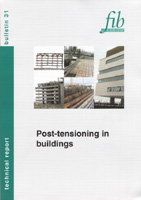Post-tensioning in buildings
Technical report (116 pages, ISBN 978-2-88394-071-0, February 2005.
fib Bulletin No. 31
Title: Post-tensioning in buildings
Category: Technical report
Year: 2005
Pages: 116
Format approx. DIN A4 (210x297 mm)
ISBN: 978-2-88394-071-0
Abstract:
The development of prestressing technology has constituted one of the more important improvements in the fields of structural engineering and construction. Referring particularly to post-tensioning applications, it is generally recognized how it opens the possibility to improve economy, structural behaviour and aesthetic aspects in concrete solutions.
In spite of the simplicity of its basic concepts and well-known advantages, the application extent of post-tensioning solutions cannot be considered harmonized in the different areas and structural applications. In fact, for various reasons, it appears that the potential offered by prestressing is far from being fully exploited, especially in building structures field. In many cases where post-tensioning would provide a visibly superior solution, it happens after all that a more conventional non-prestressed solution is often selected.
The main objective of this fib Technical Report is therefore to show the benefits of using post-tensioning for the more common practical applications in concrete buildings. The document is mainly addressed to architects, contractors and owners. It is also drafted with the goal of motivating building designers to use post-tensioning: basic design aspects related to prestressing effects and design criteria are summarized and conceptual design aspects are emphasized.
A set of practical examples is presented, showing the adopted solutions and their advantages when meeting the requirements of specific problems. The selected examples were precisely not chosen because they are outstanding structures. As a matter of fact, post-tensioning principles and technology can be used in any structure, independently of its importance, covering a wide range of building structural applications, improving the structure quality and promoting concrete as a structural material.
The advantages of using post-tensioning, concerning structural behaviour, economy, detailing and constructive aspects, are illustrated by the presentation of several existing structures, most of them designed by Working Party members. General design calculations are not presented, but design results showing the improvement in structural behaviour are illustrated.
Download the copyright page (= list of authors) as a PDF file.
Download the table of contents as a PDF file.



